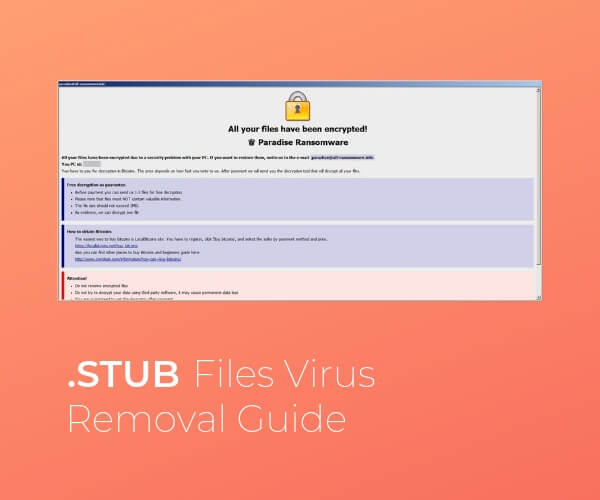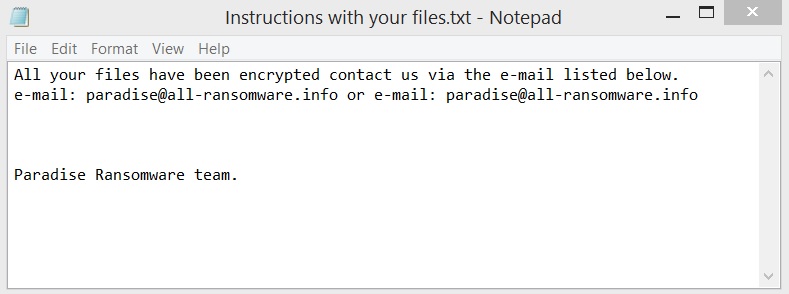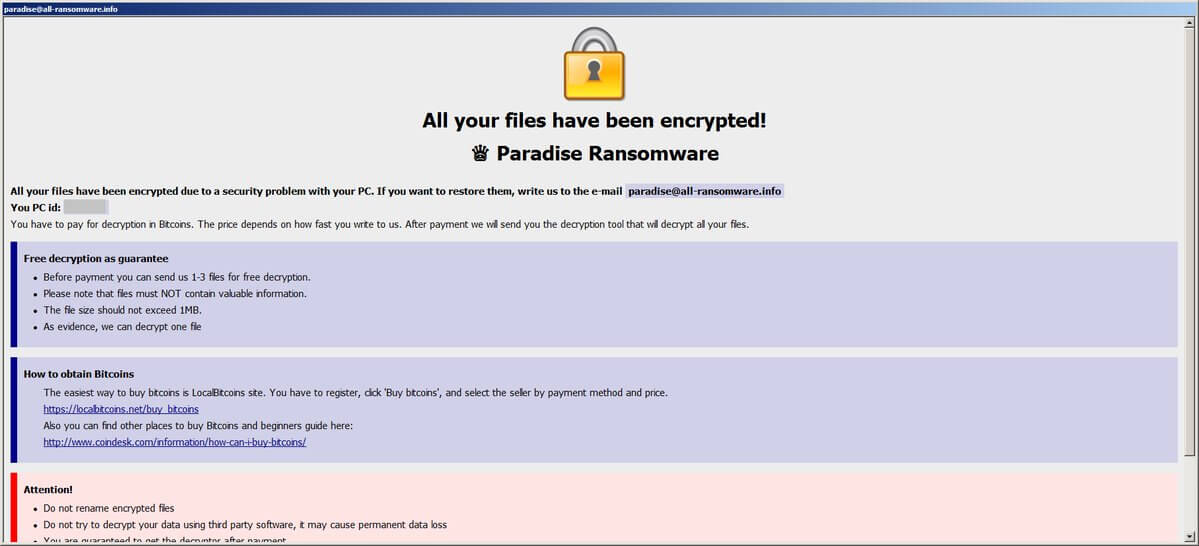In this article, you will find more information about .STUB files virus as well as a step-by-step guide on how to remove malicious files from an infected system and how to potentially recover files encrypted by this ransomware.
The .STUB files virus is the name given to a data locker ransomware that belongs to Paradise threat family. An infection with the .STUB files virus leads to the corruption of essential system settings and valuable data of yours. As a result, you see a ransom message that extorts a ransom payment for the decryption of .STUB files.

Threat Summary
| Name | .STUB Files Virus |
| Type | Ransomware, Cryptovirus |
| Short Description | Ransomware infection that plagues computer systems, encodes valuable files with strong cihper algorithm and demands a ransom fee. |
| Symptoms | Important files cannot be opened. They appear with the extension .STUB appeanded to their names. A message extorts ransom payment for files decryption. |
| Distribution Method | Spam Emails, Email Attachments |
| Detection Tool |
See If Your System Has Been Affected by malware
Download
Malware Removal Tool
|
User Experience | Join Our Forum to Discuss .STUB Files Virus. |
| Data Recovery Tool | Windows Data Recovery by Stellar Phoenix Notice! This product scans your drive sectors to recover lost files and it may not recover 100% of the encrypted files, but only few of them, depending on the situation and whether or not you have reformatted your drive. |

.STUB Files Virus – Distribution
There are several spread techniques that could be among the ones used for the distribution of .STUB ransomware. Malsam is one of those techniques. Since it enables hackers to spread their malicious code via massive email campaigns, they often prefer it.
For its realization, they usually embed their malware in files of common types after which attach these files to email messages. In addition, they configure the emails to pose as representatives of legitimate businesses or services.
The last could be explained by the fact that their purpose is to trick you into opening the corrupted file on your device. The moment you do it, you will activate the ransomware payload. A variety of common file types such as documents, PDFs, images could be transformed into carriers of ransomware code.
These files are often presented as the following:
- Invoices coming from reputable sites, like PayPal, eBay, etc.
- Documents from that appear to be sent from your bank.
- An online order confirmation note.
- Receipt for a purchase.
- Others.
Malware authors may be also using compromised software installers and infected websites to spread this nasty ransomware infection. These methods enable them to embed the ransomware payload to an app installer or inject it into a web page. Interaction with both could result in automatic and unnoticed execution of this payload directly on your system.

S.STUB Files Virus – Overview
The .STUB files virus is the name given to a data locker ransomware that belongs to [wplinkpreview url=”https://sensorstechforum.com/remove-paradise-ransomware-restore-paradise-files/”]Paradise threat family. It is designed to plague computer systems in order to encode valuable files and then extort a ransom payment for their decryption.
In the beginning, .STUB initiates the creation of several malicious files and objects which it needs for further attack operations. Like the majority of ransomware threats, this Paradise iteration is likely to drop these files in some of the following system folders:
- %AppData%
- %Local%
- %LocalLow%
- %Roaming%
- %Temp%
When .STUB is ready with the establishment of malicious files, it starts executing them in a predefined order. By doing this, the ransomware alters the settings of many system components. As a result, it becomes able to evade detection and complete the attack to its very end.
Among the affected components is likely to be the Registry Editor especially the registry sub-keys Run and RunOnce. This could be explained by the fact that the functionalities of these keys could be used for the auto-execution process of malicious files.
At last, .STUB ransomware drops the ransom message file Instructions with your files.txt to present the steps you need to perform to restore .STUB files. And here is what hackers expect you to do:
All your files have been encrypted contact us via the e-mail listed below.
e-mail: paradise@all-ransomware.info or e-mail: paradise@all-ransomware.info
Paradise Ransomware team.
In addition, your screen may be blocked by the following window:
According to hackers’ expectations, you should contact them at the presented mail and wait until they send you a reply with further instructions. Even though they don’t mention the amount of demanded ransom is not mentioned, it becomes clear that they insist that you should pay it in Bitcoins.
Beware, ransom payment does NOT guarantee the recovery of .STUB files. So our advice is to avoid ransom payment. Since there are some alternative data recovery approaches that may help you to restore some .STUB files, we recommend you to consider their usage. Meanwhile, a free decryption tool may be released by security researchers as well.

.STUB Files Virus – Encryption Process
Like its predecessors, .STUB files virus is believed to utilize the RSA cipher algorithm when it reaches the data encryption stage. Unfortunately, this means that the code of your valuable files is transformed in a way that you cannot open them. Files like:
- Audio files
- Video files
- Document files
- Image files
- Backup files
- Banking credentials, etc
will remain locked by the ransomware until their code is reverted back to its original state. A sure sign of an encrypted file is the specific sequence of two extensions appended to its name:
- _User ID_{paradise@all-ransomware.info}.STUB

Remove .STUB Files Virus and Restore Data
The so-called .STUB files virus is a threat with highly complex code designed to corrupt both system settings and valuable data. So the only way to use your infected system in a secure manner again is to remove all malicious files and objects created by the ransomware. For the purpose, you could use our removal guide that reveals how to clean and secure your system step by step. In addition, in the guide, you will find several alternative data recovery approaches that may be helpful in attempting to restore files encrypted by Paradise .STUB ransomware. We remind you to back up all encrypted files to an external drive before the recovery process.
- Step 1
- Step 2
- Step 3
- Step 4
- Step 5
Step 1: Scan for .STUB Files Virus with SpyHunter Anti-Malware Tool



Ransomware Automatic Removal - Video Guide
Step 2: Uninstall .STUB Files Virus and related malware from Windows
Here is a method in few easy steps that should be able to uninstall most programs. No matter if you are using Windows 10, 8, 7, Vista or XP, those steps will get the job done. Dragging the program or its folder to the recycle bin can be a very bad decision. If you do that, bits and pieces of the program are left behind, and that can lead to unstable work of your PC, errors with the file type associations and other unpleasant activities. The proper way to get a program off your computer is to Uninstall it. To do that:


 Follow the instructions above and you will successfully delete most unwanted and malicious programs.
Follow the instructions above and you will successfully delete most unwanted and malicious programs.
Step 3: Clean any registries, created by .STUB Files Virus on your computer.
The usually targeted registries of Windows machines are the following:
- HKEY_LOCAL_MACHINE\Software\Microsoft\Windows\CurrentVersion\Run
- HKEY_CURRENT_USER\Software\Microsoft\Windows\CurrentVersion\Run
- HKEY_LOCAL_MACHINE\Software\Microsoft\Windows\CurrentVersion\RunOnce
- HKEY_CURRENT_USER\Software\Microsoft\Windows\CurrentVersion\RunOnce
You can access them by opening the Windows registry editor and deleting any values, created by .STUB Files Virus there. This can happen by following the steps underneath:


 Tip: To find a virus-created value, you can right-click on it and click "Modify" to see which file it is set to run. If this is the virus file location, remove the value.
Tip: To find a virus-created value, you can right-click on it and click "Modify" to see which file it is set to run. If this is the virus file location, remove the value.
Before starting "Step 4", please boot back into Normal mode, in case you are currently in Safe Mode.
This will enable you to install and use SpyHunter 5 successfully.
Step 4: Boot Your PC In Safe Mode to isolate and remove .STUB Files Virus





Step 5: Try to Restore Files Encrypted by .STUB Files Virus.
Method 1: Use STOP Decrypter by Emsisoft.
Not all variants of this ransomware can be decrypted for free, but we have added the decryptor used by researchers that is often updated with the variants which become eventually decrypted. You can try and decrypt your files using the instructions below, but if they do not work, then unfortunately your variant of the ransomware virus is not decryptable.
Follow the instructions below to use the Emsisoft decrypter and decrypt your files for free. You can download the Emsisoft decryption tool linked here and then follow the steps provided below:
1 Right-click on the decrypter and click on Run as Administrator as shown below:

2. Agree with the license terms:

3. Click on "Add Folder" and then add the folders where you want files decrypted as shown underneath:

4. Click on "Decrypt" and wait for your files to be decoded.

Note: Credit for the decryptor goes to Emsisoft researchers who have made the breakthrough with this virus.
Method 2: Use data recovery software
Ransomware infections and .STUB Files Virus aim to encrypt your files using an encryption algorithm which may be very difficult to decrypt. This is why we have suggested a data recovery method that may help you go around direct decryption and try to restore your files. Bear in mind that this method may not be 100% effective but may also help you a little or a lot in different situations.
Simply click on the link and on the website menus on the top, choose Data Recovery - Data Recovery Wizard for Windows or Mac (depending on your OS), and then download and run the tool.
.STUB Files Virus-FAQ
What is .STUB Files Virus Ransomware?
.STUB Files Virus is a ransomware infection - the malicious software that enters your computer silently and blocks either access to the computer itself or encrypt your files.
Many ransomware viruses use sophisticated encryption algorithms to make your files inaccessible. The goal of ransomware infections is to demand that you pay a ransom payment to get access to your files back.
What Does .STUB Files Virus Ransomware Do?
Ransomware in general is a malicious software that is designed to block access to your computer or files until a ransom is paid.
Ransomware viruses can also damage your system, corrupt data and delete files, resulting in the permanent loss of important files.
How Does .STUB Files Virus Infect?
Via several ways..STUB Files Virus Ransomware infects computers by being sent via phishing emails, containing virus attachment. This attachment is usually masked as an important document, like an invoice, bank document or even a plane ticket and it looks very convincing to users.
Another way you may become a victim of .STUB Files Virus is if you download a fake installer, crack or patch from a low reputation website or if you click on a virus link. Many users report getting a ransomware infection by downloading torrents.
How to Open ..STUB Files Virus files?
You can't without a decryptor. At this point, the ..STUB Files Virus files are encrypted. You can only open them once they are decrypted using a specific decryption key for the particular algorithm.
What to Do If a Decryptor Does Not Work?
Do not panic, and backup the files. If a decryptor did not decrypt your ..STUB Files Virus files successfully, then do not despair, because this virus is still new.
Can I Restore "..STUB Files Virus" Files?
Yes, sometimes files can be restored. We have suggested several file recovery methods that could work if you want to restore ..STUB Files Virus files.
These methods are in no way 100% guaranteed that you will be able to get your files back. But if you have a backup, your chances of success are much greater.
How To Get Rid of .STUB Files Virus Virus?
The safest way and the most efficient one for the removal of this ransomware infection is the use a professional anti-malware program.
It will scan for and locate .STUB Files Virus ransomware and then remove it without causing any additional harm to your important ..STUB Files Virus files.
Can I Report Ransomware to Authorities?
In case your computer got infected with a ransomware infection, you can report it to the local Police departments. It can help authorities worldwide track and determine the perpetrators behind the virus that has infected your computer.
Below, we have prepared a list with government websites, where you can file a report in case you are a victim of a cybercrime:
Cyber-security authorities, responsible for handling ransomware attack reports in different regions all over the world:
Germany - Offizielles Portal der deutschen Polizei
United States - IC3 Internet Crime Complaint Centre
United Kingdom - Action Fraud Police
France - Ministère de l'Intérieur
Italy - Polizia Di Stato
Spain - Policía Nacional
Netherlands - Politie
Poland - Policja
Portugal - Polícia Judiciária
Greece - Cyber Crime Unit (Hellenic Police)
India - Mumbai Police - CyberCrime Investigation Cell
Australia - Australian High Tech Crime Center
Reports may be responded to in different timeframes, depending on your local authorities.
Can You Stop Ransomware from Encrypting Your Files?
Yes, you can prevent ransomware. The best way to do this is to ensure your computer system is updated with the latest security patches, use a reputable anti-malware program and firewall, backup your important files frequently, and avoid clicking on malicious links or downloading unknown files.
Can .STUB Files Virus Ransomware Steal Your Data?
Yes, in most cases ransomware will steal your information. It is a form of malware that steals data from a user's computer, encrypts it, and then demands a ransom in order to decrypt it.
In many cases, the malware authors or attackers will threaten to delete the data or publish it online unless the ransom is paid.
Can Ransomware Infect WiFi?
Yes, ransomware can infect WiFi networks, as malicious actors can use it to gain control of the network, steal confidential data, and lock out users. If a ransomware attack is successful, it could lead to a loss of service and/or data, and in some cases, financial losses.
Should I Pay Ransomware?
No, you should not pay ransomware extortionists. Paying them only encourages criminals and does not guarantee that the files or data will be restored. The better approach is to have a secure backup of important data and be vigilant about security in the first place.
What Happens If I Don't Pay Ransom?
If you don't pay the ransom, the hackers may still have access to your computer, data, or files and may continue to threaten to expose or delete them, or even use them to commit cybercrimes. In some cases, they may even continue to demand additional ransom payments.
Can a Ransomware Attack Be Detected?
Yes, ransomware can be detected. Anti-malware software and other advanced security tools can detect ransomware and alert the user when it is present on a machine.
It is important to stay up-to-date on the latest security measures and to keep security software updated to ensure ransomware can be detected and prevented.
Do Ransomware Criminals Get Caught?
Yes, ransomware criminals do get caught. Law enforcement agencies, such as the FBI, Interpol and others have been successful in tracking down and prosecuting ransomware criminals in the US and other countries. As ransomware threats continue to increase, so does the enforcement activity.
About the .STUB Files Virus Research
The content we publish on SensorsTechForum.com, this .STUB Files Virus how-to removal guide included, is the outcome of extensive research, hard work and our team’s devotion to help you remove the specific malware and restore your encrypted files.
How did we conduct the research on this ransomware?
Our research is based on an independent investigation. We are in contact with independent security researchers, and as such, we receive daily updates on the latest malware and ransomware definitions.
Furthermore, the research behind the .STUB Files Virus ransomware threat is backed with VirusTotal and the NoMoreRansom project.
To better understand the ransomware threat, please refer to the following articles which provide knowledgeable details.
As a site that has been dedicated to providing free removal instructions for ransomware and malware since 2014, SensorsTechForum’s recommendation is to only pay attention to trustworthy sources.
How to recognize trustworthy sources:
- Always check "About Us" web page.
- Profile of the content creator.
- Make sure that real people are behind the site and not fake names and profiles.
- Verify Facebook, LinkedIn and Twitter personal profiles.





